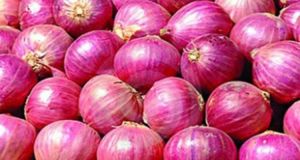
Fresh White Onion
Get Price Quote

Onions
11 Per Kilogram
5 Metric Ton (MOQ)
Best Deals from Onions

Onions
Get Price Quote
An Introduction to Onions Onion, one of the most widely used vegetables of the world, is a root vegetable used as a seasoning in fresh and dry forms. This underground bulb is known for its distinct/pungent flavor and aroma. It is an inseparable element of almost every meat dish. But its use is not only confined to the non-vegetarian items, it also mixes well with various vegetables. Needless to explain its utility in preparing the soup, stew, stir-fry, salad and sauce. Today, onions are used in a variety of dishes and rank sixth among the world’s leading vegetable crops. For the past five thousand years, this root vegetable is used in one form or another by humans. In the general sense, the word ‘onion’ can be used for any plant in the genus Allium, but used without qualifiers usually means Allium cepa, which is also known by the names of ‘garden onion’ or ‘bulb’ onion and ‘shallot’. Onions are classified in two categories viz. green (“scallions”) and dry onions. It is believed that this plant has been originated in Asia. It contains protein, sugars, cellulose, minerals, a fixed oil, an essential oil and over 80 per cent water. Brief History Findings and records suggest that onions were originated several thousands years ago in South Asia. In Caananite Bronze Age settlements, traces of onion remains were found alongside fig and date stones dating back to 5000 BC. It is regarded as an inseparable element of almost every Indian cuisine. Though a portion of Indian population did not consume this vegetable due to religious forbiddance, it is one of the most widely cultivated vegetable of the country. When onion was introduced in Egypt, it became more than just food. Archaeological findings suggest that the ancient Egyptians worshipped the onion, believing that its spherical shape and concentric rings symbolized eternity. It is also believed that the workers who built the Egyptian pyramids may have been fed radishes and onions. Onions were even used in Egyptian burials as evidenced by onion traces being found in the eye sockets of Ramesses IV. In 1492, Christopher Columbus has introduced onions in North America. It was used in various forms in various cultures. Greek athletes ate large quantities of onion because it was believed that it would lighten the balance of blood. Roman gladiators were rubbed down with onion to firm up their muscles. Plant Description Onion is an annual plant which is cultivated for its bulbous root, which is pungent and/or sweet in varying degrees. It is hardly grown as a biennial crop. A sandy, fertile loam is the best soil for growing onions. As a cold weather crop, onion plant needs cool climate to grow their green tops and warm weather to ripen the bulbs. The plant require good drainage and plenty of sunlight. The plant can grow upto two feet in height. It has upright, cylindrical, green leaves attached to the swollen leaf bases that form the bulb below ground. Culinary Uses For centuries, this root vegetable has been widely used a basic flavouring in the kitchen. It is one of those vegetables which are used as a vegetable, or as a spice to bring out the flavour of other dishes without overpowering them. The paste of onion in combination with garlic and ginger, is the basic element of every meat dish prepared in Indian subcontinent. This root vegetable is also used in soups, pickles and cooked vegetable dishes, sauces, hearty casseroles, and bean and lentil dishes. It is a common ingredient in marinades, and an onion studded with cloves is often a main flavouring in stocks and courts-bouillons. Nutritional Value Onions are regarded as an antiseptic, diuretic, expectorant and rubefacient by the nutritionists. Its juice or paste is used for wound healing, skin complaints (acne), insect bites, hemorrhoids, boils and toothache. The raw juice is diuretic and the whole onion is an appetite stimulant and digestant.

Onion
Get Price Quote

Red Onion
Get Price Quote
Red Onion, Fresh Vegetables, Sand Stone